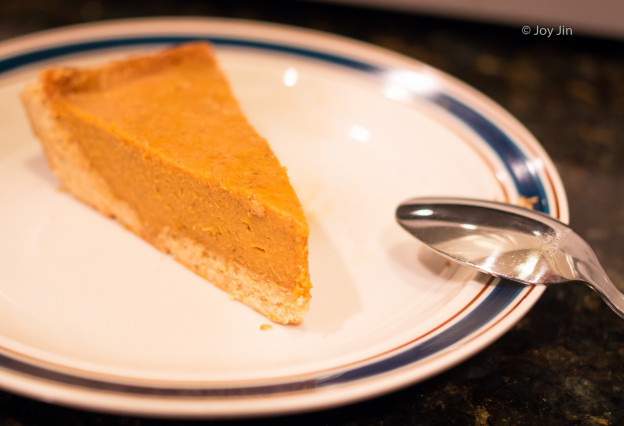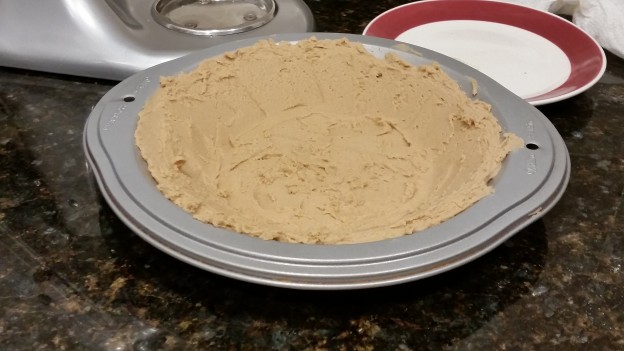(Photo courtesy of Joy.)
Thursday, November 27, 2014 – It’s Thanksgiving. My friends know I bake epic-level desserts. They also know I have a knack for cookies. So of course, I revive the cookie crust pie. Except instead of a chocolate filling, I go for a pumpkin pie filling.
(Side note: cookie crusts were relatively obscure when I started making them in 2012. Now they’re pretty common. It kinda annoys me. I guess I’m a food hipster.)
Day 1 was assembling the cookie dough. Pictured here is the cookie crust before baking. Last time I was making cookie crusts, I was in my oil cookie phase. As it turns out, oil cookies don’t work (but that’s another blog post). So I had to reformulate my cookie crust based on my new recipes and my new learnings.
Lucky for me, my new learnings tell me a lot about how to control the shape and texture of a cookie. The obvious one is increased flour. I usually do 280g, but this time I’ll increase it by 25% to 350g to help the cookie crust keep it’s shape. (We don’t want too much flour, or the dough will dry out.) And of course, the crust needs to be slightly crispy, so we’ll use a/p flour instead of bread flour. (Yes, my cookie recipe uses bread flour. Gluten is awesome.)
On the fat side, shortening doesn’t melt at room temperature, but butter tastes so much better, so we’ll split the difference and do half shortening and half butter. I wanted to use butter-flavored shortening, but they apparently only sell butter-flavored shortening in stick form and not in tub form, which makes it harder to portion. So I just used regular plain old shortening.
Finally, I reduced the brown sugar from 300g to 200g. (My cookies don’t use white sugar (aka granulated sugar). Molasses is awesome like that.) This serves two purposes. One, less sugar means the cookie crust keeps its shape better. Two, the chocolate chip cookie pie I made two years ago was super overly sweet, so the crust doesn’t need to be super sweet either. (Or so I thought. More on this later.)
Day 2 was baking the cookie crust and making the filling. (I know I said “no bake”. The crust is baked. The filling is not.) To bake, I covered the cookie dough with parchment paper and weighed it down with pie weights. You could get actual pie weights, or you could do what Alton Brown suggests and use black beans. (Although a lot of people are now recommending metal nuts and bolts. Possibly Alton Brown too, but I can’t find the source.) And then, I popped it in the oven at 425 F for 15 minutes.
Still trying to figure out the best baking temperature, time, and process. I Clearly baked the cookie too hot and too long, since the edges are burnt. Fortunately, one of my previous experiments tells me that cookies don’t caramelize if you bake them at 325 F, so I guess I should bake them at 325 F and rely on the pie weights and the ingredient ratios to keep the pie pie-like.
Not pictured is, after I remove the pie weights, I need to bake them for another 10 minutes. Again, still working out the temperature and time.
Next step was the pumpkin pie filling. Since I’ve never made pumpkin pie before, I decided to scour the internet for a recipe. I wanted a filling I didn’t have to bake, since I didn’t want to double-bake my cookie crust. Unfortunately, most of the fillings online were either made with Jello pudding mix (ew) or eggs. And there’s nothing wrong with eggs, but proper egg custards require baking.
So back to the drawing board. Last time I made this pie, I used a chocolate pudding as the filling. So why not make a pumpkin pudding? A base of milk, sugar, and cornstarch, and add some pumpkin puree. The good news is, the pumpkin puree was already thick, so I didn’t need to simmer for 30 minutes like I did with chocolate pudding. I just need to get the pumpkin pudding paste up to a boil (and by boil, I mean a few bubbles), and I was good to go. Took me all of 5 minutes.
Of course, pumpkin pie doesn’t really taste like pumpkin. It has a pumpkin base, but then you spice it up with something the marketing world calls “pumpkin spice”. As it turns out, you can make pumpkin spice with nutmeg, cinnamon, cloves, and ginger. I used about 1/2 tsp of each in my pumpkin pudding. I think I used too much cloves though. Note to self, use less cloves.
You might notice in the picture that I cut off the burnt edges. There was enough filling to almost completely fill the pie. If I didn’t burn the edges, I might want to increase the filling by, I dunno, 20% to fill up tha extra space. Also, unlike my chocolate pudding, it wasn’t sweet enough. Not to self, use more sugar, for both the crust and the filling.
Or maybe it’s fine as is. At the Thanksgiving party, I got compliments about how well-spiced the pie was and how it wasn’t overly sweet. So I guess my guests liked it more than I did.
Bonus: Gluten-free pumpkin puree. As if pumpkin puree could have gluten.




